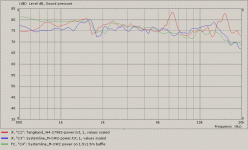My understanding is that most cones are cone shaped to maintain stiffness so they don't bend. Only in the past (couple?) decades or so have have certain new materials become common that are stiff enough to make a flat diaphragm out of without bending. Usually sandwich materials made from kevlar or carbon fiber with a honeycomb Nomex or similar type core, or in this case, Aluminum. There are several flat speakers on the market but they aren't as common as they could be and I'm not sure why. This one looks interesting.
Found more info in another forum:
http://www.htguide.com/forum/showthread.php4?t=30060
Found more info in another forum:
http://www.htguide.com/forum/showthread.php4?t=30060
That impedance plot shows where the breakup is. Quite nasty too.
But damn thats a good-looking driver. 😎
But damn thats a good-looking driver. 😎
The W4-1757S is a little different. Lighter cone and Xmax of 2mm not 3mm. But probably representative of the design.
The B&W Nautilus uses a flat diaphragm 4" lower mid unit, you now have the driver to do a clone with!
Very interesting driver, will be interested if anyone gets these. There are at least 2 different photos of them around, compare the datasheet to the parts express photo, and then the photo on the linked htguide thread seems to have a more blue looking diaphragm!
EDIT: there are 2 different flat drivers by TB? It's the W4-1757S that has 2 different photos, and the original posted one appears to be a different/new model.
Very interesting driver, will be interested if anyone gets these. There are at least 2 different photos of them around, compare the datasheet to the parts express photo, and then the photo on the linked htguide thread seems to have a more blue looking diaphragm!
EDIT: there are 2 different flat drivers by TB? It's the W4-1757S that has 2 different photos, and the original posted one appears to be a different/new model.
Is that hexa-grid detachable? Looks interesting, but I still think there's a little way to go before flat diaphragm speakers will be really competitive.
"Flat cone" - it's actually more descriptive than "flat diaphragm", but then sounds silly when you think about it... 🙂
"Flat cone" - it's actually more descriptive than "flat diaphragm", but then sounds silly when you think about it... 🙂
If you are curious about flat drivers in general, you might google FAL for some eye candy. Peter Daniel has discussed them over here, so check the forum too. They are a fine looking (and sounding, by all accounts) speaker, but not quite as affordable as the TB.
Paul
Wild Burro Audio Labs - DIY Full Range Speakers
Paul
Wild Burro Audio Labs - DIY Full Range Speakers
I'll continue to search the threads on the subject of notch filters for the 1798S, but would like to know more regarding how the driver performs with those filters in place, just general impressions. Without notch filters, there's certainly a harshness to the driver as I listen, as well as, to use pseudo-technical audiophile babble, a lack of resolution, of fine detail.
Since the latter is usually closely related to the distortion levels, I suggest you seek out some harmonic distortion plots, if any have been taken, which may give you an idea of what is going on. THD won't tell you anything of particular value, but 2nd, 3rd, 4th & 5th order graphs certainly will.
There isn't a whole lot that can be done about these & the noise floor without redesigning the driver itself or making physical changes; they're basically inherent to the unit.
There isn't a whole lot that can be done about these & the noise floor without redesigning the driver itself or making physical changes; they're basically inherent to the unit.
- Status
- Not open for further replies.
- Home
- Loudspeakers
- Full Range
- Flat cone drivers - opinions?
